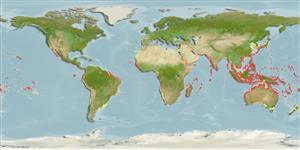Common names from other countries
Classification / Names / Names
Common names | Synonyms | Catalog of Fishes (gen., sp.) | ITIS | CoL | WoRMS
Environment: milieu / climate zone / depth range / distribution range
Ecology
Epiphytic; depth range 1 - 31 m (Ref. 102164). Tropical
Indo-Pacific and Atlantic Ocean.
Length at first maturity / Size / Weight / Age
Maturity: Lm ? range ? - ? cm
Thalli prostrate, greenish to purple, forming thick clumps of intricating branches on rocky substrate. Branches terete to slightly compressed, 1.5 to 3 mm broad. Branching irregularly alternate to opposite, forming wide angles and rounded axils. Branches divided into short stubby spines at the terminal portion; the short ultimate branchlets are characteristically stout, stubby, and spinose. Thalli up to 8 cm in height (Ref. 80758).
Source of protein and carrageenan; used for human consumption, as animal feed, medicine (antitumor) and as fertilizer; used as coconut manure in Brazil and West Indies (Ref. 80758); of low commercial interest internationally as carrageenan source (Ref. 82223). Hypnea plants have compounds with medical and pharmaceutical uses such as muscle relaxants and blood agglutinins (reviewed in Schenkman, 1989) (Ref. 82232).
Guiry, M.D. and G.M. Guiry. 2009. (Ref. 80701)
IUCN Red List Status (Ref. 130435: Version 2024-1)
CITES status (Ref. 108899)
Not Evaluated
Not Evaluated
Threat to humans
Human uses
Fisheries: commercial
| FishSource |
Tools
More information
Age/SizeGrowthLength-weightLength-lengthMorphologyLarvaeAbundance
Internet sources
Estimates based on models
Preferred temperature
(Ref.
115969): 22.7 - 29.2, mean 28.1 (based on 4511 cells).
